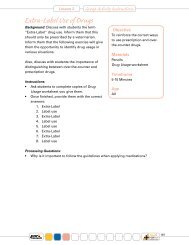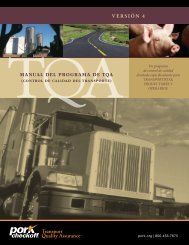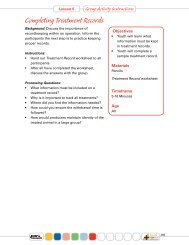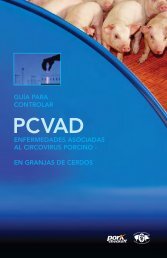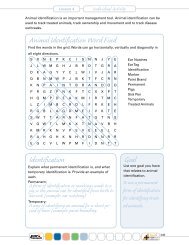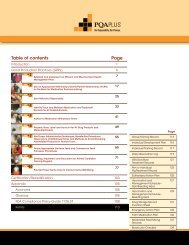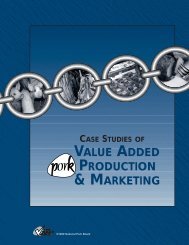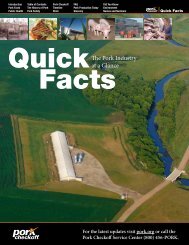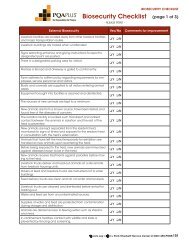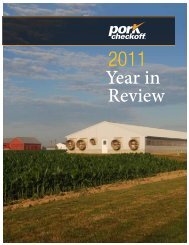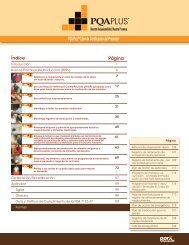PRRS Compendium Producer Edition - National Pork Board
PRRS Compendium Producer Edition - National Pork Board
PRRS Compendium Producer Edition - National Pork Board
You also want an ePaper? Increase the reach of your titles
YUMPU automatically turns print PDFs into web optimized ePapers that Google loves.
In the female, the reproductive consequences of receiving virus-contaminated semen are minimal, providing<br />
semen quality is acceptable. Several studies have been unable to demonstrate reduced fertilization<br />
or conception rates following insemination of virus contaminated semen (Lager et al., 1997; Prieto et al.,<br />
1997). Of more importance is the likelihood of transmitting <strong>PRRS</strong> virus to the recipient female resulting in<br />
clinical disease in that animal and subsequent spread to other animals in the herd (Prieto et al., 1997; Yaeger<br />
et al., 1993). Introduction of <strong>PRRS</strong> virus-contaminated semen is a constant threat to herd biosecurity.<br />
Clinical Disease in Lactating Sows and Neonates<br />
Clinical signs of <strong>PRRS</strong> virus infection observed in neonates during acute outbreaks can be quite remarkable<br />
(Keffaber, 1989; Loula, 1991). The first sign is often severe respiratory disease in pigs less than two<br />
weeks of age. The respiratory rate becomes markedly elevated and the depth of respiration increases to<br />
the point where each breath is evident by the pronounced movement of the chest and abdomen. Severely<br />
affected pigs will exhibit open-mouth breathing and the respiration will become so rapid as to make it<br />
impossible to accurately determine the respiratory rate. Central nervous signs, including drowsiness and<br />
anorexia, along with corresponding microscopic lesions in the brain were reported by Rossow et al. (1999).<br />
Other clinical signs reported in neonates include edema around the eyes, conjunctivitis, blue discoloration<br />
of ears, bruising of the skin, diarrhea, shaking, rough hair coats and profuse bleeding post-injection (Rossow,<br />
1998). Whether some of these clinical signs, such as diarrhea, are directly attributable to <strong>PRRS</strong> virus<br />
infection is debatable and may be due other secondary infections.<br />
Simultaneously, or within a few days of the appearance of disease in neonates, weak-born pigs and stillbirths<br />
become more frequent. Weak-born pigs fail to move beyond the rear of the sow and often die within<br />
a few hours. The rate of stillborn pigs can reach 75%. Often as an outbreak progresses and dead fetuses<br />
have more time to undergo the process of mummification, the rate of stillbirths declines and the rate of<br />
mummified fetuses increases. Finally, small litters may be observed due to embryonic death during early<br />
pregnancy.<br />
The impact on the health status of lactating sows is similar to gestating sows. Loss of appetite and fever<br />
leads to agalactia, which results in starvation of the piglets or development of diseases that are controlled<br />
by maternal immunity such as colibacillosis. In total, preweaning mortality rates can exceed 80% in severe<br />
cases (Christianson et al., 1991).<br />
Clinical Disease from Weaning to Market<br />
As with the breeding herd, the impact of <strong>PRRS</strong> virus infections in pigs after weaning can be highly variable.<br />
Pig age influences the severity of disease (Rossow et al., 1994). In the experience of this author, it<br />
appears that 8 weeks of age is an important break point with regard to the severity of disease induced by<br />
experimental challenge. In the field, most clinicians would agree that younger pigs tend to develop more<br />
severe disease, although in an individual herd, the timing of infections with other pathogens will influence<br />
disease severity as well. <strong>PRRS</strong> virus infections of weaned pigs can persist within a herd essentially<br />
forever because each new group of young pigs is susceptible to infection following the decay of colostral<br />
immunity (Dee et al., 1997). Infection during pregnancy can sometimes occur without any obvious harm<br />
to the pig. Infection with <strong>PRRS</strong> virus alone can markedly reduce growth rates, although mortality rates are<br />
usually only mildly elevated unless other pathogens are present. In field cases, reduced growth rates are<br />
frequently observed and increased rates of cull or light pigs occur (Keffaber, 1989). Nursery daily gains can<br />
be reduced by 50-75% and mortality rates can rise to 10-25% in field situations (Keffaber, 1989). In a recent<br />
study, Regula et al. (2000) reported that finishing pigs that seroconverted to <strong>PRRS</strong> virus gained 40 grams<br />
per day less than pigs that did not seroconvert.<br />
Experimentally, infection of high health status pigs results in no, or slight, death loss and a 25-40% reduction<br />
in daily gain in the first 28 days following experimental challenge (Thacker et al., 1998). Clinical signs<br />
include fever (>40° C), anorexia, and an increased respiration rate that is especially pronounced after handling<br />
the pigs for rectal temperature assessment or blood collection.<br />
As stated above, the earlier in life that a pig becomes infected with <strong>PRRS</strong> virus, the more severe the clinical<br />
outcome will be. This finding is corroborated by field experiences that suggest avoiding circulation of<br />
<strong>PRRS</strong> virus in nurseries appears to be very important with respect to the overall performance of the finishing<br />
herd. Under field conditions, pigs are typically infected with other pathogens prior to, during, and/or<br />
PAGE PIG 04-01-09





